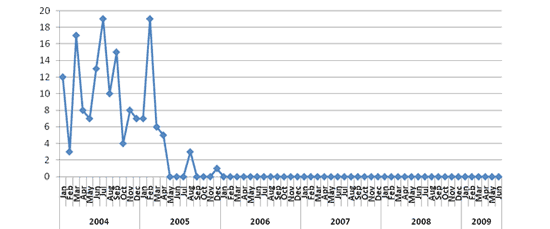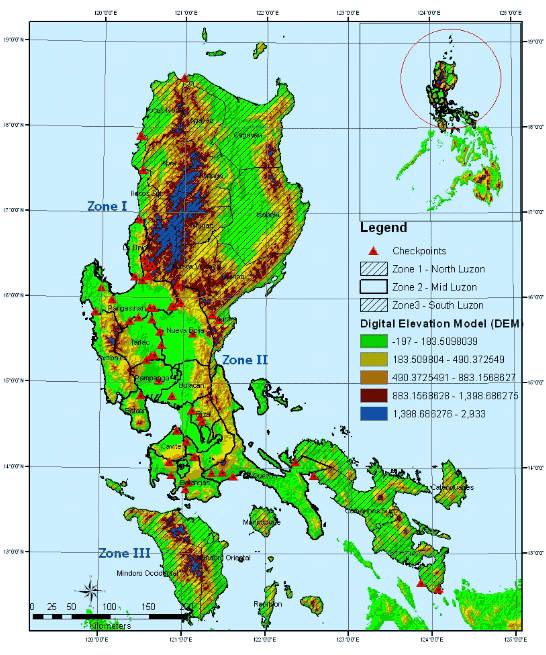Activities based on the four components of the program (Disease Monitoring and Surveillance, Public Awareness, Animal Movement Management and Vaccination) were accordingly stepped-up in a focused intervention on the identified critical pathway of animals, from the source to the market, see annex 1. critical pathway diagram. Disease monitoring and surveillance were intensified with strict documentation of disease status in the field through the submission of incidence and negative monitoring reports, sero-surveillance was also conducted routinely in the free (OIE recognized and locally declared) and control zones, collecting a total of 22,083 samples in 2004 and 2005. High-risk areas were identified based on the sero-surveillance, and vaccination of all susceptible animals in these places was targeted in preparation for the rainy season - the time when the highest number of outbreaks occurs.
Documentation of all shipments of FMD susceptible animals, particularly swine was also institutionalized through a system of accreditation of commercial or breeder farms to ensure that only healthy animals were shipped out to the market. This has been made as a requirement for the deputation system of private practitioners as special quarantine officers (SQO) who were given the privileged authority to issue shipping permits, under pain of losing their license in cases of malicious discharge of their function as SQO. A “no- document-no slaughter” policy in slaughterhouses and a “no-document-return-to-origin” policy on quarantine checkpoints were also issued to enjoin compliance to the documentation system. Additional checkpoints, operating 24 hours a day in key areas going to the NCR and the protected areas in Luzon, were established to support monitoring activities and compliance to existing guidelines in shipping of susceptible animals. To date, 53 such veterinary checkpoints are in place in Luzon alone.
Along this line, field coordination was directed to the smallest government units possible such as the cities/municipalities in an effort to enjoin all local chief executives in the campaign, as local government units (LGU) have a relative degree of administrative autonomy under the Local Government Code. While BAI also has no technical or administrative control over these offices, its presence in requesting support at the grass roots level has proven to be effective, especially in meeting with local chief executives, as it was better able to project the bigger picture of the campaign at the national perspective, while outlining the needs and benefits at the grass roots. The most important part of the campaign to sustain the activities of the program at the LGU level is the advocacy for the passage of local ordinances or laws enforcing the national guidelines for the control and eradication of FMD.
The focused intervention on each sector of the critical pathway, based on the four components of the strategy coupled with the aggressive implementation of all related policies, have significantly curbed the number of outbreaks in the endemic area, and for the first time in ten years, a zero case scenario was achieved nationwide for 6 months in 2005, and sustained to date, see Figure 1.
Figure 1. Monthly outbreak report 2004-2009

As a result of dedicated implementation of guidelines for the progressive zoning approach, the zero case scenarios was sustained to date, with continuous complementation of stricter animal movement management and sustained cooperation of all concerned stake holders. Luzon at present is virtually divided into three zones designated as: Zone 1 (North Luzon), 2 (Mid-Luzon) and 3 (South Luzon)see Figure 2.
Figure 2. Digital elevation model of Philippines’ FMD Zoning

Current zoning of Luzon was based primarily on status of disease freedom (with or without vaccination) and on geography and movement management of FMD susceptible animals.
The whole island group of Luzon has been without clinical cases for 364 months since the last recorded outbreak in December 2005. No vaccination activity has been done in Zones 1 and 3 since 2003.
Geographically, entry to Zone 1 can only be made through two main roads complemented with full veterinary quarantine facilities. No other road tributaries are present since further north to Zone 1 is a mountainous area. Entry to Zone 3 is also through one main road, also complemented by a veterinary quarantine facility and further travel to the south consists of mountain ranges. These mountain ranges in both the north and south provide a natural barrier to keeping said zones disease free and keepsZone 2 isolated.
The Philippines is now in the process of withdrawing vaccination against FMD in the country, given the very small percentage of farmers still using vaccination and in due consideration of the fact that the last type of virus found in the country is a pig-loving strain” and that selective stamping out was carried out to complement a strict movement management control.




